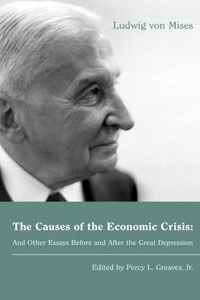
The Causes of the Economic Crisis, and Other Essays Before and After the Great Depression
Stimulus or laissez-faire? That’s the essential debate about what to about financial crisis in our time. It was the same in the 1930s.
In this world before and after the Great Depression, there was a lone voice for sanity and freedom: Ludwig von Mises. He speaks in The Causes of the Economic Crisis, a collection of newly in print essays by Mises that have been very hard to come by, and are published for the first time in this format.
Here we have the evidence that the master economist foresaw and warned against the breakdown of the German mark, as well as the market crash of 1929 and the depression that followed.
He presents his business cycle theory in its most elaborate form, applies it to the prevailing conditions, and discusses the policies that governments undertake that make recessions worse. He recommends a path for monetary reform that would eliminate business cycles and provide the basis for a sustainable prosperity.
In foreseeing the interwar economic breakdown, Mises was nearly alone among his contemporaries. In 1923, he warned that central banks will not “stabilize” money; they will distort credit markets and generate booms and busts. In 1928, he departed dramatically from the judgment of his contemporaries and sounded an alarm: “every boom must one day come to an end.”
Then after the Great Depression hit, he wrote again in 1931. His essay was called: “The Causes of the Economic Crisis.” And the essays kept coming, in 1933 and 1946, each explaining that the business cycle results from central-bank generated loose money and cheap credit, and that the cycle can only be made worse by intervention.

